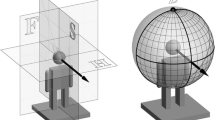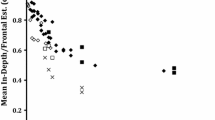Abstract
The “visual space” of an optical observer situated at a single, fixed viewpoint is necessarily very ambiguous. Although the structure of the “visual field” (the lateral dimensions, i.e., the “image”) is well defined, the “depth” dimension has to be inferred from the image on the basis of “monocular depth cues” such as occlusion, shading, etc. Such cues are in no way “given”, but are guesses on the basis of prior knowledge about the generic structure of the world and the laws of optics. Thus such a guess is like a hallucination that is used to tentatively interpret image structures as depth cues. The guesses are successful if they lead to a coherent interpretation. Such “controlled hallucination” (in psychological terminology) is similar to the “analysis by synthesis” of computer vision. Although highly ambiguous, visual spaces do have geometrical structure. The group of ambiguities left open by the cues (e.g., the well known bas-relief ambiguity in the case of shape from shading) may be interpreted as the group of congruences (proper motions) of the space. The general structure of visual spaces for different visual fields is explored in the paper. Applications include improved viewing systems for optical man-machine interfaces.
Similar content being viewed by others
References
Abbot, E., Flatland, E.: A Romance of Many Dimensions. Buccaneer Books, Cutchogue (1976) (first edition 1884)
Adelson, E.H., Bergen, J.R.: The plenoptic function and the elements of early vision. In: Landy, M., Movshon, J.A. (eds.) Computational Models of Visual Processing, pp. 3–20. MIT Press, Cambridge (1991)
Ames, A. Jr.: The illusion of depth from single pictures. J. Opt. Soc. Am. 10, 137–148 (1925)
Alexander, H.G. (ed.): The Leibniz-Clarke Correspondence. Manchester University Press, Manchester (1956)
Barre, A., Flocon, A.: La Perspective Curviligne, de l’Espace Visuel à Limage Construite. Flammarion, Paris (1968)
Belhumeur, P.N., Kriegman, D.J., Yuille, A.L.: The bas-relief ambiguity. Int. J. Comput. Vis. 35, 33–44 (1999)
Bell, J.L.A.: Primer of Infinitesimal Analysis. Cambridge University Press, Cambridge (1998)
Berkeley, G.: An essay towards a new theory of vision (1709). In: Theory of Vision and Other Writing by Bishop Berkeley. Dent and Sons, New York (1925)
Blank, A.A.: The Luneburg theory of visual space. J. Opt. Soc. Am. 43, 717–727 (1953)
Born, M., Wolf, E.: Principles of Optics: Electromagnetic Theory of Propagation, Interference and Diffraction of Light. Cambridge University Press, Cambridge (1999)
Brentano, F.: Psychology from Empirical Standpoint. Routledge, London (1995) (original 1874)
Brown, J.W.: Fundamentals of process neuropsychology. Brain Cogn. 38, 234 (1998)
Carrol, L.: Alice’s Adventures in Wonderland. Macmillan, London (1865)
Cayley, A.: Sixth memoir upon the quantics. Philos. Trans. Rcmillan, R. Soc. Lond. 149, 61–70 (1859)
Cornish, V.: Scenery and the Sense of Sight. Cambridge University Press, London (1935)
Coxeter, H.S.M.: Introduction to Geometry. Wiley Classics Library Series, New York (1989)
Denis, M.: Manifesto of symbolism. Revue Art et Critique (1890)
Destombes, M.: Guillaume Postel cartographe. In: AAVV, Guillaume Postel 1581–1981. Actes du Colloque International d’Avranches, pp. 361–371. Guy Trédaniel, Paris (1985)
Donders, F.C.: Anomalies of Accommodation and Refraction. New Sydenham Society, London (1864)
Dubery, F., Willats, J.: Perspective and Other Drawing Systems. Van Nostrand Reinhold, New York (1983)
Duke-Elder, S.: The Eye in Evolution. System of Opthalmology, vol. I. Kimpton, London (1958)
Edwards, W., Lindman, H., Savage, L.J.: Bayesian statistical inference for psychological research. Psychol. Rev. 70, 193–242 (1963)
Foley, J.M.: The size-distance relation and intrinsic geometry of visual space: implications for processing. Vis. Res. 12, 323–332 (1972)
Gibson, J.J.: The Perception of the Visual World. Houghton-Mifflin, Boston (1950)
Gibson, J.J.: The Senses Considered as Perceptual Systems. Houghton-Mifflin, Boston (1966)
Gombridge, E.: Art and Illusion: A Study in the Psychology of Pictorial Representation. Phaedon, London (1969)
Graham, C.H.: Vision and Visual Perception. Wiley, New York (1966)
Hale, N.C.: Abstraction in Art and Nature. Watson-Guptill, New York (1972)
Hauck, G.: Die subjektive Perspektive und die Horizontalen Curvaturen des Dorischen Styls. Wittwer, Stuttgart (1875)
von Helmholtz, H.: Die Tatsachen in der Wahrnehmung. Hirschwald, Berlin (1878)
von Helmholtz, H.: Handbuch der Physiologischen Optik. Voss, Leipzig (1860)
Hess, R.F.: Developmental sensory impairment: amblyopia or tarachopia? Hum. Neurobiol. 1, 17–29 (1982)
Hilbert, D., Cohn-Vossen, S.: Geometry and the Imagination. Dover, New York (1944) (Orig. (G.) Anschauliche Geometrie, 1932)
Hildebrand, A.: The Problem of Form in Painting and Sculpture (transl. by M. Meyer and R.M. Ogden). Stechert, New York (1945) (First, German edition, Das Problem der Form, 1893)
Husserl, E.: Logische Untersuchungen. Zweite Teil: Untersuchungen zur Phaenomenologie und Theorie der Erkenntnis (1901)
Jacobs, T.S.: Drawing with an Open Mind. Watson-Guptil, New York (1986)
Jäne, B.: Practical Handbook on Image Processing for Scientific and Technical Applications. CRC Press, Boca Raton (2004)
Jaynes, E.T.: Prior probabilities. IEEE Trans. Syst. Sci. Cybern. 4, 227–241 (1968)
Kheirandish, E.: The Arabic Version of Euclid’s Optics. Springer, New York (1998)
Klein, C.F.: Vergleichende Betrachtungen über neuere geometrische Forschungen. Andreas Deichert, Erlangen (1872)
Klein, F.: Über die sogenannte nicht-Euklidische Geometrie. Math. Ann. 6, 112–145 (1871)
Klein, F.: Vorlesungen über nicht-Euklidische Geometrie. Springer, Berlin (1928)
Koenderink, J.J.: The concept of local sign. In: van Doorn, A.J., van de Grind, W.A., Koenderink, J.J. (eds.) Limits in Perception. VNU Science Press, Utrecht (1984)
Koenderink, J.J., van Doorn, A.J.: The generic bilinear calibration-estimation problem. Int. J. Comput. Vis. 23, 217–234 (1997)
Koenderink, J.J., van Doorn, A.J.: Exocentric pointing. In: Harris, L.R., Jenkin, M. (eds.) Vision and Action, pp. 295–313. Cambridge University Press, Cambridge (1998)
Koenderink, J.J., van Doorn, A.J., Kappers, A.M.L., Todd, J.T.: Ambiguity and the “mental eye” in pictorial relief. Perception 30, 431–448 (2001)
Koenderink, J.J., van Doorn, A.J., Lappin, J.S.: Direct measurement of the curvature of visual space. Perception 29, 69–79 (2000)
Koenderink, J.J., van Doorn, A.J., Kappers, A.M.L., Todd, J.T.: Pappus in optical space. Percept. Psychophys. 64, 380–391 (2002)
Koenderink, J.J., van Doorn, A.J., Lappin, J.S.: Exocentric pointing to opposite targets. Acta Psychol. 112, 71–87 (2003)
Kumler, J.J., Bauer, M.: Fisheye lens designs and their relative performance. Proc. SPIE 4093, 360–369 (2000)
Listing, J.B.: Beitrag zur physiologischen Optik, Göttinger Studien. Vandenhoeck and Ruprecht, Göttingen (1845)
Lotze, H.: Mikrokosmos. Ideen zur Naturgeschichte und Geschichte der Menschheit. Versuch einer Anthropologie. Hirzel, Leipzig (1876)
Luneburg, R.K.: Mathematical Analysis of Binocular Vision. Princeton University Press, Princeton (1947)
Luneburg, R.K.: The metric of binocular visual space. J. Opt. Soc. Am. 40, 627–642 (1950)
Martin, G.: An owl’s eye; schematic optics and visual performance in Strix aluco L. J. Comput. Physiol. 145, 341–349 (1982)
Marr, D.: Vision. Freeman, San Francisco (1982)
Mercator, G.: Atlas sive Cosmographicae Meditationes de Fabrica Mundi et Fabricati Figura, Duisburg, 1595. Lessing J. Rosenwald Collection, Library of Congress
Naber, G.L.: The Geometry of Minkowski Spacetime. Springer, New York (1992)
Nicod, J.: La géométric dans le monde sensible. Thèse, University of Paris, Paris (1923)
Palmer, S.E.: Vision Science: Photons to Phenomenology. MIT Press, Cambridge (1999)
Pasch, M.: Vorlesungen über neuere Geometrie von M. Pasch. Teubner, Leipzig (1912)
Pirenne, M.H.: Optics, Painting and Photography. Cambridge University Press, Cambridge (1970)
Poggio, T.: Low-level vision as inverse optics. In: Rauk, M. (ed.) Proceedings of Symposium on Computational Models of Hearing and Vision, pp. 123–127. Academy of Sciences of the Estonian S.S.R. (1984)
Poincaré, H.: Science et la Méthode. Flammarion, Paris (1908)
Riedl, R.: Die Ordnung des Lebendigen. Systembedingungen der Evolution. Paul Parey, Hamburg (1975)
Riemann, B.: Ueber die Hypothesen, welche der Geometrie zu Grunde liegen (Aus dem dreizehnten Bande der Abhandlungen der Königlichen Gesellschaft der Wissenschaften zu Göttingen), 10 June 1854
Sachs, H.: Ebene isotrope Geometrie. Friedrich Vieweg, Braunschweig (1987)
Sachs, H.: Isotrope Geometrie des Raumes. Friedrich Vieweg, Braunschweig (1990)
Schlosberg, H.: Stereoscopic depth from single pictures. Am. J. Psychol. 54, 601–605 (1941)
Searle, J.: The Rediscovery of the Mind. MIT Press, Cambridge (1992)
Siegel, M., Tobinaga, Y., Akiya, T.: Kinder gentler stereo. IS&T/SPIE’98 1-10 (1998)
Spivak, M.: Comprehensive Introduction to Differential Geometry. Publish or Perish, Berkeley (1990)
Strubecker, K.: Differentialgeometrie des isotropen Raumes I. Sitzungsber. Akad. Wiss. Wien 150, 1–43 (1941)
Strubecker, K.: Differentialgeometrie des isotropen Raumes II. Math. Z. 47, 743–777 (1942)
Strubecker, K.: Differentialgeometrie des isotropen Raumes III. Math. Z. 48, 369–427 (1943)
Strubecker, K.: Differentialgeometrie des isotropen Raumes IV. Math. Z. 50, 1–92 (1945)
Swift, J.: Gulliver’s Travels and Other Works. Routledge, London (1906) (orig. 1726)
Witgenstein, L.: Tractatus Logico-Philosophicus. Routledge and Kegan Paul, London (1922) (German text with an English translation on regard by C.K. Ogden; with an introduction by Bertrand Russell)
Yaglom, I.M.: A Simple Non-Euclidean Geometry and Its Physical Basis: An Elementary Account of Galilean Geometry and the Galilean Principle of Relativity (transl. by A. Shenitzer). Springer, New York (1979)
Yaglom, I.M.: Complex Numbers in Geometry (transl. by E. Primrose from 1963 Russian original). Academic Press, New York (1968)
Zeiss, C., von Rohr, M.: Linsensystem zum einaugigen Betrachten einer in der Brennebene befindlichen Photographie. Kaiserliches Patentamt Patentschrift Nr. 151312 Klasse 42h. (1904)
Zeiss, C., von Rohr, M.: Instrument zum beidäugigen Betrachten von Gemälden. Kaiserliches Patentamt Patentschrift Nr. 194480 Klasse 42h Gruppe 34. (1907)
Yuille, A., Kersten, D.: Vision as Bayesian inference: analysis by synthesis? Trends Cogn. Sci. 20, 1–7 (2006).
Zucker, S.W.: The emerging paradigm of computational vision. Ann. Rev. Comput. Sci. 2, 69–89 (1987)
Author information
Authors and Affiliations
Corresponding author
Rights and permissions
About this article
Cite this article
Koenderink, J., van Doorn, A. The Structure of Visual Spaces. J Math Imaging Vis 31, 171–187 (2008). https://doi.org/10.1007/s10851-008-0076-3
Received:
Accepted:
Published:
Issue Date:
DOI: https://doi.org/10.1007/s10851-008-0076-3




